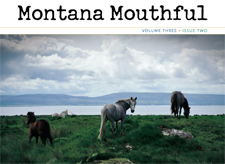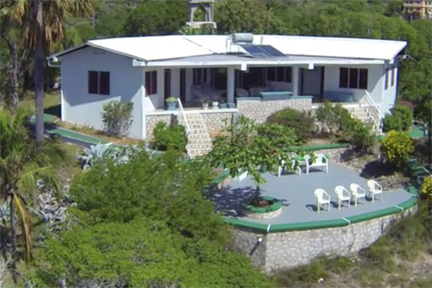 Published by Montana Mouthful in May 2020
Published by Montana Mouthful in May 2020
If we were silent, the forest ranger told us, most of the animal world we rode through would be unaware of us — up here holding tight to the rails of the howdah against the gently rocking pace – and so would not be afraid or even timid. Just another elephant, they would think, whose careless, huge and clumsy feet needed watching but otherwise needing little attention.
And so it proved: We soon lumbered by a deer and its newborn, the fawn camouflaged in dappled spots and curled into the belly of the dozing doe, probably nursing. I wished the elephant might pause long enough for me to get out my camera, but dared not speak to ask that, so didn’t get a photo.
In the six decades since that magical morning, the teak industry of the Western Ghats on India’s Deccan Plateau has disappeared; Wikipedia tells me tersely that “much of the forest has been degraded through overuse.”
But in 1957 teak was a major occupation, and elephants did the heavy work. My wife and I, spending three months wandering through India, had spent Christmas with a British Quaker in the Nilgiri Hills, at the southern tip of the Deccan not far from Madurai. She urged us to stop in the forest on our way north, and – a wonder, then! — had a telephone and helped set up the visit.
That included arranging to stay in a dak bungalow, and inveigling the government ranger to give us a tour of his dry upland jungle.
The British, during their time as colonial masters, set up dak bungalows all over India — little more than bed, bath and tiny kitchen, comparable to a basic motel of the day — to accommodate minor poohbahs or bureaucrats out touring the countryside on various governmental errands. When not so in use, they could be rented for a few rupees a night.
Although told there would be some cooking utensils and tableware, we weren’t up to grocery shopping. Instead, we had a late-afternoon supper in an unpretentious eatery in the roadside commercial cluster where the bus – save for its gaudy paint, a model American schoolchildren would have recognized — let us down. We then bought a few pieces of breakfast fruit at a roadside stand before shouldering our knapsacks and hiking in a half mile to the bungalow as dusk overtook us. We soon turned in, because the man who had agreed to give us a tour would pick us up not long after dawn.
We were up early, had a spartan breakfast and were waiting. One couldn’t have missed hearing the elephant galumphing down the grassy two-rutted trail, hardly wide enough for a Jeep, that we’d walked the evening before.
The uniformed ranger greeted us, and his mahout – a skinny kid, legs wrapped in a flowing cotton dhoti, wearing a short-sleeved cotton shirt – had the elephant kneel so we could climb up for proper introductions. We would spend perhaps two hours, he said, mostly through the virgin forest but ending up in the part being harvested.
The fawn and doe were the first of a dozen forest denizens we encountered, from parrots and macaws to monkeys. The ranger would silently point them out, and sometimes would tap the mahout to pause for a moment. He sat astride the elephant’s neck with his ankus, a goad with sharpened point and hook.
At one point the boy stopped on his own and turned to tell the ranger that he’d picked up the track of a tiger or leopard and would try to follow it. That turned out not to last long; the track disappeared. After a time we put silence aside and enjoyed a rambling lecture on the forest and its inhabitants, the monsoon rains now behind us that nourished the land, the silviculture of teak and the intertwined lives of villagers and their docile tuskers.
Another vivid memory of that exotic ride: At several points we rode out of the tall forest and through a sunny canebrake, a thicket of bamboo that towered over us despite our being ten feet off the ground. The elephant, prodded sometimes with the ankus, would stomp with his right foot to mash the bamboo on that side, then with his left to mash to the other side, and then take several careful stomping steps more to clear a path through the bamboo hedge.
He rewarded himself, I noticed: As he stepped through each such opening, he would reach to the side with his long trunk to break off a few branches, and would nibble bamboo greens as he took us back into more open forest.
We ended our tour at the scene of the teak harvest, where a dozen teams of men with two-man saws a New Englander could recognize were felling giant trees and cutting them into measured lengths. Under the British, a century earlier, some 40,000 teak trees were felled annually. Some went to build Royal Navy sailing vessels, but most had a mundane destination: sleepers, or ties, as the Brits crisscrossed their empire with railroads.
By the time we visited, the harvest was less – lacking an adequate reforestation effort, the forest was thinner – and some went for a more noble purpose, furniture. An older man, armed with sticks topped with sponge-like, paint-soaked windings, came around examining each log and hammering a color-code daub onto the fresh-sawn butt.
The elephants, our ranger explained, would come be harnessed to drag the logs and – without needing help from their mahouts – team up with each other to hoist them into color-coded piles to await being trucked to the sawmill!
We thanked our guide and young man, bestowing on each such largesse as we could afford, and hiked back out to the paved road and commercial strip for a late lunch. Then we went back to the bungalow for a nap before what would prove the capper of the day: bath time.
That scene was a mile away, where a small river ran through a clearing in the woods. As instructed, we arrived early and found a hillside vantage point overlooking a trampled sea of mud. Soon, the elephants arrived, mahouts on their necks, and made their way belly-deep into the river. The boys had left their sharp goads with whatever other harness the elephants had shucked, and now wielded long-handled scrub brushes.
It is a vivid image in my memory: Each elephant would suck up trunkfuls of river water and spray its own back as its mahout – who in due course got a pretty good shower-bath himself – pranced along its back, scrubbing vigorously. When each animal was deemed clean enough, its mahout would again bestride the neck and guide his beast to stand in a long line of elephants waiting to be fed.
The boy would then walk to the foot of the line, to a kitchen of huge pots slung over wood fires. There, pachyderm supper was being made: rice, with other grains and nourishing ingredients, was cooked into a sludge thicker than oatmeal. That pottage became firm enough to be tipped out and rolled into huge pills the size of medicine balls. Each mahout would in turn manage to get a supper-ball up onto his shoulder and stagger back to his animal, hoisting it up. His elephant would wave its trunk up out of the way, and open what I remember as a pointed lower lip into which supper was deposited, to be contentedly masticated.
We couldn’t help noticing that one elephant, in line relatively near the cooking pots, was not being fed. As each mahout went by, supper ball on his shoulder, the poor elephant would lift its trunk skyward and open its mouth hungrily, as though pleading – only to see each meal carried farther to one of its companions.
We had by now found an older man who spoke enough English to help us understand the scene before us. He explained that the elephant was sick, and its supper-ball would come last because medicine would be kneaded into it. We waited, and indeed that elephant was the last fed; we left it at last contentedly chewing.
As each elephant finished its supper, we had noticed, an iron chain and shackle was bolted onto one foot — or sometimes two feet were chained loosely together. They would spend the night, our newfound guide explained, browsing on their own, quite likely heading back to the canebrake thickets of bamboo we’d been taken through. They would munch whatever greenery they found, and then would settle down to sleep. For most, a single noisy ankle-chain would be enough to remind them that they were domestic animals and should not try to wander away.
Having watched the elephants fed, we went back to the road for supper ourselves, then repaired to our bungalow to catch up diaries. Not until much later would we realize we’d visited a dying industry. There are efforts to preserve the elephant population in the Deccan, but the teak is gone, and it’s hard to imagine anything to match the independent usefulness we’d witnessed.
Next morning we breakfasted at the roadside and soon boarded a bus for Mysore, the next stop on our long Indian peregrination.
-End-





